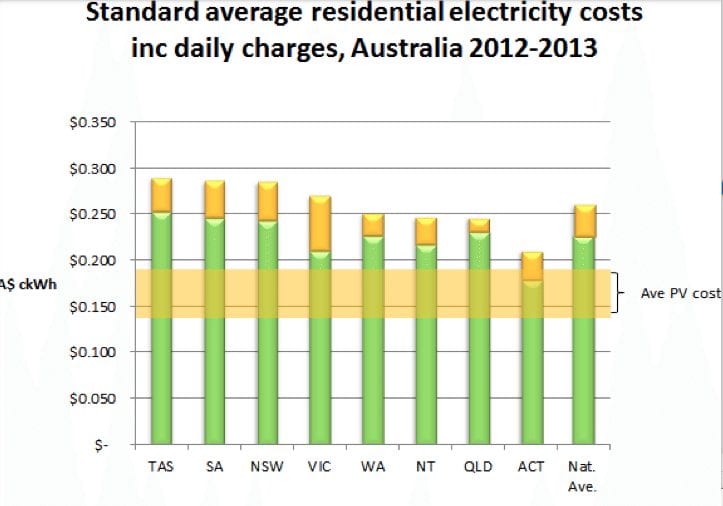There now seems little doubt that “socket parity” is well and truly established in Australia, and rooftop solar can be installed and deliver electricity at lower rates than the main grid.
Last week we published a graph from Exigency showing how much could be saved in each state from rooftop PV, today we offer a different perspective from Nigel Morris, from Solar Business Services, which shows a comparison with grid charges and the range in solar costs.
What’s interesting about this graph is that it includes the standing charges being paid by household clients. There are two points to be made here – one is that these are often forgotten by consumers, but they add to the total cost.
The other is that as the standing charges grow, it actually reduces the attraction of solar PV to consumers – this is often regarded as the fall-back position for utilities: if they worry that too much solar PV is being deployed and their revenues are affected they simply ramp up the standing charge to the point where the numbers do not seem quite as attractive.
However, there appears to be a massive amount of confusion in the market about the tariffs on offer – even among the utilities themselves. That was one issue highlighted by this piece we published last week, but Morris says the confusion is widespread. “It’s a total mess,” he says.
New name for peak body as solar comes of age
The Australian Solar Energy Society (AuSES), the peak body of the Australian solar energy industry, is celebrating its 50th anniversary by announcing a change of name to the Australian Solar Council. CEO John Grimes says the decision to drop the word “society” and replace it with “council” reflects the emergence of solar as a multi-billion dollar industry in Australia, where four million people enjoy some form of solar energy. “We have been waiting for solar to come of age, we’ve been supporting demonstration projects and technologies at the early stage of commercialisation,” he told RenewEconomy. “Now we now that solar works and we can count on it, and it’s a rational economic choice.”
Grimes said the council would help ensure Australian policy-makers were better informed about solar energy and the huge potential for its future development, which is tipped to increase from its current deployment of around 1,700MW to 10 times that number or even 20 times that number by 2030. “Solar presents a massive challenge to the traditional energy generators who rely on fossil fuel sources,” he said. ” Our job will be to dispel the myths and misinformation that is put to policy-makers and the public about the practicalities and potential of solar as the driver of Australia’s clean energy future.”
Among the principal challenges for the revamped body and the industry were the rolling out of financial products that would allow zero-down financing, leveraging Australia’s expertise in off-grid energy for deployment in the Asia-Pacific region, and ensuring the right of access to solar for all consumers.
The ACT Government says it will release the results of its reverse auction for large-scale solar in a few weeks, and expects it will prove the price competitiveness of Big Solar, and make the case for such a scheme to be implemented on a national level.
ACT Energy Minister Simon Corbell, the driving force behind the scheme, said on Tuesday he expected it to produce “remarkable” results. A total of 10 projects from six different proponents made the final cut for the initial auction of around 20MW. “When the price is known, it will be time for the rest of Australia and in particular the Federal Government to reconsider its approach to supporting Big Solar, and establish a reverse auction process to make Big Solar happen at the national level,” Corbell told the East Solar conference in Melbourne.
Corbell says the ACT will have allocated 40MW of large-scale feed in tariff support by July next year, and he expected the timetable for further tranches of the 210MW available for deployment under the scheme to be announced in coming months. He expected the full capacity to be allocated by 2016.
Corbell said the auction would demonstrate that large-scale solar can be delivered efficiently without complex subsidy arrangements or taxpayer risk, unlike the Federal Government’s Solar Flagships process. “The ACT scheme leaves the risk of deployment, including technology, siting and land acquisition, planning and development approvals to the proponent, with no upfront taxpayer subsidy required,” he said. The feed in tariff is not paid until the generator is generating, and the contract is passed on to another bidder.
“Secondly, the feed-in tariff scheme has the ability to bring forward the deployment of large-scale renewable generation, which would otherwise not yet be viable. By having a price for difference mechanism in place,where the level of feed in tariff payment reduces over time as the wholesale price of electricity rises, the cost to electricity consumers is minimised yet deployment happens more promptly than if generators were waiting for the price differential to close.”










